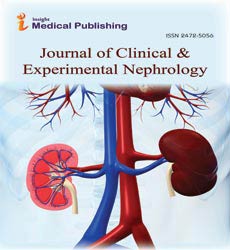Bladder Stones: Causes, Symptoms and Treatments
Ernesto Andres
Department of Genetics, Physiology and Microbiology, Complutense University, Madrid, Spain
Published Date: 2024-12-09DOI10.36648/2472-5056.9.6.287
Ernesto Andres*
1Department of Genetics, Complutense University, Madrid, Spain
- *Corresponding Author:
- Ernesto Andrés,
Department of Genetics, Complutense University, Madrid, Spain
E-mail: ernestoandres@ma.sp
Received date: November 25, 2024, Manuscript No. IPJCEN-24-19996; Editor assigned date: November 30, 2024, PreQC No. IPJCEN-24-19996(PQ); Reviewed date: December 13, 2024, QC No. IPJCEN-24-19996; Revised date: December 20, 2024, Manuscript No. IPJCEN-24-19996 (R); Published date: December 27, 2024, DOI: 10.36648/2472-5056.9.6.287
Citation: Andres E (2024) Bladder Stones: Causes, Symptoms and Treatments. J Clin Exp Nephrol Vol.9 No.6: 287.
Description
Bladder stones are solid formations or crystals that develop in the bladder, typically as a result of concentrated urine. These stones can differ in size and may range from a tiny particle to a sizable mass that could result in considerable discomfort. Bladder stones, although relatively less frequent than kidney stones, represent a significant medical issue and can cause various complications if not addressed promptly. Conditions that limit the flow of urine from the bladder, such as a urethral stricture or a tumor, can aid in the development of bladder stones. Prolonged inflammation in the bladder caused by conditions like cystitis or other bladder ailments can improve the chances of stone formation. A diet rich in certain components like calcium or oxalate may play a role in the emergence of bladder stones. However, the dietary connection is more evident in kidney stones in comparison to bladder stones. Specific medical ailments, including gout, hyperparathyroidism and Inflammatory Bowel Disease (IBD), can increase an individual's vulnerability to bladder stones.
Symptoms of bladder stones
The manifestations of bladder stones can differ depending on the stone's size and the degree of its effect on the bladder. Some individuals may experience no symptoms at all, while others may endure considerable discomfort.
Painful urination: A sensation of sharp pain or discomfort while urinating is a prevalent indication. The pain may be experienced at the start or throughout the entire process of urination.
Frequent urination: Individuals with bladder stones frequently experience the urge to urinate more often, even if the bladder is not filled to capacity.
Urinary retention: In particular instances, the stone can obstruct urine flow, making it hard to completely empty the bladder.
Blood in the urine: Hematuria, or the occurrence of blood in the urine, is another sign that may suggest the presence of bladder stones. The blood can be observable or identified via a urinalysis.
Lower abdominal pain: As the stones irritate the bladder, individuals may experience discomfort or a feeling of pressure in the lower abdominal region.
Foul-smelling urine: Bladder stones can occasionally lead to infections, which can result in alterations in the urine’s appearance or odor.
Diagnosis
A healthcare professional usually diagnoses bladder stones through a combination of medical history, physical evaluation and diagnostic procedures. Some common methods of diagnosis include
Urinalysis: A straightforward urine test can detect the presence of blood, infection, or crystals, which are all indicators of bladder stones.
Imaging tests: X-rays or CT scans may be utilized to identify the stones. Ultrasound of the abdomen or pelvis can also reveal bladder stones, particularly in patients who are unable to undergo X-ray or CT imaging.
Cystoscopy: This procedure consists of inserting a small camera through the urethra to directly observe the bladder and confirm the existence of stones.
Blood tests: Blood tests might be conducted to investigate underlying issues, such as kidney disorders or infections, that could be aiding in the development of stones.
Treatment of bladder stones: The approach to treating bladder stones varies based on their size, position and the symptoms they are causing.
Conservative management: In situations where the stone is small and resulting in minimal symptoms, a healthcare professional may suggest consuming ample fluids to assist in naturally expelling the stone. Occasionally, medications may also be given to help ease the bladder and promote stone passage.
Surgical removal: If the stones are sizable or leading to considerable symptoms, surgical intervention may be required. The most prevalent surgical methods.
Cystolitholapaxy: This technique involves fragmenting the stone using a cystoscope and then flushing the fragments out of the bladder.
Cystotomy: In more serious instances, a small cut may be made in the bladder to extract larger stones.
Medications: In certain situations, medications may be utilized to address underlying issues, such as urinary tract infections, or to assist in dissolving specific types of stones.
Conclusion
Bladder stones, while not as common as kidney stones, represent a considerable health concern that can result in discomfort, infection and various complications. The causes range from urinary retention and dehydration to underlying health conditions. Prompt diagnosis and treatment are vital to preventing additional complications. With suitable management, bladder stones can be effectively addressed vital to preventing additional complications. With suitable management, bladder stones can be effectively addressed and their recurrence can be limited by implementing preventive strategies, including adequate hydration and handling contributing factors.
Open Access Journals
- Aquaculture & Veterinary Science
- Chemistry & Chemical Sciences
- Clinical Sciences
- Engineering
- General Science
- Genetics & Molecular Biology
- Health Care & Nursing
- Immunology & Microbiology
- Materials Science
- Mathematics & Physics
- Medical Sciences
- Neurology & Psychiatry
- Oncology & Cancer Science
- Pharmaceutical Sciences
